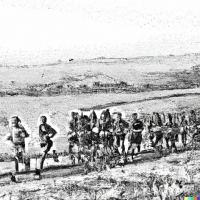How to Do Interval Running Part 2
Follow the link for How to Do Interval Running Part 1.Interval running, an effective method to improve running speed and overall fitness, involves short, high-intensity intervals followed by longer lower-intensity rest periods. Here's how to kickstart your journey into interval running, starting with warming up correctly.
The Right Warming Up for an Interval Workout

So follow my lead, this is the warming-up regime I usually follow: commence your warm-up session with five to ten minutes of light jogging. This helps to elevate heart rate, pump more oxygen to muscles and warm up your joints, thereby preparing your body for the upcoming vigorous activity of interval running.
After light jogging, proceed with some dynamic stretching, targeting key muscle groups used in running, such as hip flexors, glutes, hamstrings and calves. Unlike static stretching, dynamic stretching mimics the motions of running, making it more suitable for a warm-up.
For more detail on this warm-up, check out my page on running stretches.
The Signs of Overexertion when Doing an Interval Workout

Common signs of overexertion are:
Being tuned in to your body helps in identifying overexertion. If your heart rate fails to restore to a baseline range during rest intervals, it can reflect overexertion. To stay safe, make sure to gradually increase your training load.
Let those first few weeks of intervals be a little easy. It is a good feeling when you finish your interval workout and you feel like you could have gone a bit longer!
Cooling Down after Interval Running

After your run, you can do some static stretches as explained on the running stretches page. This helps to reduce muscle tension and improve flexibility.
Best Terrain for Intervals

Find a path that is a bit quieter and without traffic lights or crossings. Basically somewhere where you don't have to worry about looking out for cars, navigating past other pedestrians etc.
When you have created those circumstances for yourself, you have got the best control on managing your output in each interval. Simple as that.
Sure, you can do intervals in the hills as well. When you are practicing for a hilly trail race or ultra in the hills or mountains, doing a lot of your running, including intervals, in the hills as well is logical.
But, I am assuming you belong to the majority of runners who might be running for fitness, for weight loss and maybe for a local 5k, half marathon or even marathon. For you, flat surfaces work best.
How to Incorporate Intervals into Your Weekly Routine

Therefore do a maximum of one workout per week that is faster than easy running. One interval session is plenty when you are starting out.
Once your body adapts to this form of training, you can gradually increase to two hard sessions per week, with ample recovery time in-between. Balance your interval training with relaxed, easier and longer runs.
Common Mistakes When Doing Interval Workouts

Too Fast
A frequent mistake is overdoing the speed during high-interval sessions. This can lead to fatigue midway through the workout or even injury.
Skipping Recovery Time
Skipping recovery time in between high-intensity intervals is also another pitfall to avoid. The recovery period in between is as important as the fast interval. It allows your heart rate to lower and your body to regenerate before the next intense phase.
Too Many Hard Workouts in a Week
Running consistently at fast paces during all your workouts in the week could lead to overtraining and plateauing in performance. Many of us, when we begin to run, run our easy runs too fast. As a result, when it comes to our intervals, we start them tired and do them too slow.
It's much better to maintain a balance between hard and easy workouts in your weekly running schedule.

Another common mistake is not warming up or cooling down properly. As covered earlier, warm-ups and cool-downs are an important part of interval workouts. They help prepare your body and aid in recovery post-workout, respectively.
Trying to Keep Up With Faster Runners
When you are new to running and you are running with a group, you might feel tempted to match the pace of more experienced runners during interval sessions. But remember everyone has their unique pace. To steer clear from injuries and preserve performance, it is vital to run at a pace suitable for your fitness level.
Conclusion
In a nutshell, interval running can be an empowering training routine that can boost your running performance and overall fitness. Whether you're planning to incorporate interval workouts, fartlek workouts, or other types of hard runs, remember the tips on this page.
Understanding your body, warming up, running on suitable terrains, listening to your body for signs of overexertion, cooling down, as well as integrating your interval running correctly into your weekly schedule is essential to keep improving performance without an increased injury risk or compromising your enjoyment.
Remember, steady progression is key to sustained success and enjoyment in the sport. Happy running!
Oh, and if you missed part 1 of this article, check it out by following the link: How to Do Interval Running Part 1
Home > Beginner Running Tips > How to Do Interval Running Part 2
What's New?
-
In the Army - Improving my 2 Mile Time
I am a 36 year old male who just joined the army. I have not run any long distance so I tried on my own to train and was doing ok but my times are still -
Marathon Diet - Improve Nutrition to do Better at the Marathon
I have got a question about my marathon diet. I have been an athlete all my life; mostly a runner, but cycle long distances sometimes. I am training -
Beginners Running Program 3 - Go from 0 to 30 Minutes of Running in 12 Weeks
The third beginners running program of Best Running Tips might be the best one. It is definitely the most popular. Get from couch to 30 minutes of solid running in only 12 weeks! -
Calories Burned Calculator - Calculate the Calories Burned While Running with This Calculator
This calories burned calculator calculates the calories burned while running, based on your weight and the distance you ran. -
Asthmatic Non-Runner With a Need to Run - 1.5 Miles in 13 Minutes
Truth be told I am NOT a runner. I can walk a 14 minute mile all day. But running, not me. I have had asthma since I was a child - severe through all -
Second Half Marathon in a Month - Should I Run It or Not?
Hi, I ran a half marathon a month ago, but have not done any great distances since, 6 miles max. I'm thinking of doing a half marathon this Sunday -
Running a 5k - Can I Be Faster at 30 Than I Was at 18?
I started running at 13 in high school. I ran cross-country, indoor and outdoor track. My track coach was very informed and my PRs were 800 - 2:22, -
Faster Minute Mile for 5K races
I'm 40 years old and I started to run consistently four months ego. My running pace went from 9 minutes miles to 7:30 minute miles in a 5k. Is it realistic -
I Need a Good Marathon Running Program
I am devastated. I ran my second marathon last weekend. I ran a marathon six months ago as well, but at about the 19-20 mile mark my legs cramped up... -
Is 20 to 30 Training Miles Enough to Run a Half Marathon
I have been a committed runner for a year and a half now and have completed two half marathons with over a dozen 10k races! I have been keeping running



